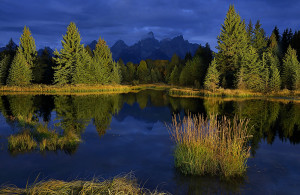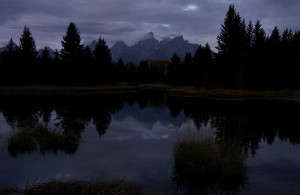
Hi and welcome to this 11th year of Workshop at the Ranch (WATR). This month I am proud to announce the release of my
NEW Lightpainting video on KelbyOne www.kelbyone.com .
Lightpainting Grand Landscapesis the third in a series of my Lightpainting videos available on KelbyOne.
For those not familiar with KelbyOne this is the online creation of Scott Kelby, where any photographer can find online video courses teaching nearly every photographic subject imaginable. You can either become a yearly member and have all the archives of online training courses available to you, or if you are not a KelbyOne member don’t give up because you can simply rent a single course one at a time.
Using night vision video cameras the KelbyOne film crew captures 90 minutes of step-by-step explanation and instructional demonstration as I actually Lightpaint several landscapes in Teton National Park, and also the famous Barns on Mormon Row near Jackson Hole, Wyoming.
My first two Lightpainting videos on KelbyOne, Painting with Light: A Unique Approach, and Lightpainting: Illuminating Models teach you Lightpainting from A-Z, including the “Soft Focus” technique. But this NEW video really breaks out of the box as I show you how to Lightpaint large-scale outdoor Landscapes.
So let’s learn about just one of the techniques I teach on the Lightpainting Grand Landscapes video…how to Lightpaint at twilight.
 Image #1 Schwabacher Landing Twilight (WB Daylight) Image #1 Schwabacher Landing Twilight (WB Daylight) … With my camera secured to my tripod I began Lightpainting my landscapes on the video during twilight…about 20-30 minutes after sunset. Typically a photographer will have the camera’s White Balance (WB) set to Daylight or for me 5,500K as I use the Kelvin Scale. I usually begin my Manual exposure at ISO500, 30 seconds shutter speed, at an aperture of f8. I know that I need 30 seconds to Lightpaint a large area, and I usually want a sufficient depth of field so I use an aperture of f8. With these two pieces of the exposure puzzle set I place my ISO at ISO500 and make a test shot (Blank Image) without any Lightpainting. I don’t actually use a lightmeter for my Lightpaintings. Rather, I use the Blank Image to “visually” determine my ISO setting. If the Blank Image is too dark I will raise the ISO and make another Blank Image…if it is too bright I reduce the ISO. I want the sky to be visible yet underexposed…after all it’s twilight. I need the subject (the trees at Schwabcher Landing) to be in silhouette. I will reveal the trees from silhouette with Lightpainting. Nikon D800, ISO500, 30 seconds, f8, Nikon 24-70mm lens, WB 5500K, Manfrotto Tripod with 410 Geared Head, Brinkmann Max Million II, SanDisk 32G Flash Card. |
 Image #2 Schwabacher Landing Twilight (WB 4000K) … Now I set my WB at 4000K to Cool Blue the entire scene…and I make a Blank Image just to be sure I like the twilight exposure. If you do not use the camera’s Kelvin Scale just set your WB to incandescent or fluorescent and the scene will become a similar cool blue color. The cool blue silhouetted “canvas” is now ready for the subject to be illuminated with Lightpainting. Nikon D800, ISO500, 30 seconds, f8, Nikon 24-70mm lens, WB 4000K, Manfrotto Tripod with 410 Geared Head, Brinkmann Max Million II, SanDisk 32G Flash Card. Image #2 Schwabacher Landing Twilight (WB 4000K) … Now I set my WB at 4000K to Cool Blue the entire scene…and I make a Blank Image just to be sure I like the twilight exposure. If you do not use the camera’s Kelvin Scale just set your WB to incandescent or fluorescent and the scene will become a similar cool blue color. The cool blue silhouetted “canvas” is now ready for the subject to be illuminated with Lightpainting. Nikon D800, ISO500, 30 seconds, f8, Nikon 24-70mm lens, WB 4000K, Manfrotto Tripod with 410 Geared Head, Brinkmann Max Million II, SanDisk 32G Flash Card.
|
 Image #3 Schwabacher Landing Twilight (Lightpainted) … I use the Brinkmann Max Million II Spot Light for my landscape Lightpaintings. The Brinkmann Max Million II is a hand held rechargeable spotlight that produces 2 million candles of illumination. I do not stand next to the camera while applying the light during the 30 seconds of exposure time. Rather, I walk off camera from to the right about 60 yards so as to illuminate the subject with “Off Camera Light”. The camera’s Self-Timer allows me to press the shutter and have 20 seconds to walk off camera before the shutter opens. The light from the Brinkmann is a very warm toned incandescent light. At a WB setting of 4000K the warm color light from the Brinkmann balances out to a slightly “Golden Hour” color on our silhouetted subject. Ah Golden Hour…whenever I want it. Nikon D800, ISO500, 30 seconds, f8, Nikon 24-70mm lens, WB 4000K, Manfrotto Tripod with 410 Geared Head, Brinkmann Max Million II, SanDisk 32G Flash Card. Image #3 Schwabacher Landing Twilight (Lightpainted) … I use the Brinkmann Max Million II Spot Light for my landscape Lightpaintings. The Brinkmann Max Million II is a hand held rechargeable spotlight that produces 2 million candles of illumination. I do not stand next to the camera while applying the light during the 30 seconds of exposure time. Rather, I walk off camera from to the right about 60 yards so as to illuminate the subject with “Off Camera Light”. The camera’s Self-Timer allows me to press the shutter and have 20 seconds to walk off camera before the shutter opens. The light from the Brinkmann is a very warm toned incandescent light. At a WB setting of 4000K the warm color light from the Brinkmann balances out to a slightly “Golden Hour” color on our silhouetted subject. Ah Golden Hour…whenever I want it. Nikon D800, ISO500, 30 seconds, f8, Nikon 24-70mm lens, WB 4000K, Manfrotto Tripod with 410 Geared Head, Brinkmann Max Million II, SanDisk 32G Flash Card. |
While this short WATR article gives you an idea about the potential of Lightpainting, my 90 minute KelbyOne video captures me actually demonstrating Lightpainting and making this very same image plus others on location in Teton National Park.
Remember that you don’t need to be a yearly member to access online KelbyOne courses. Many of these online courses are available to rent. So “click” on the KelbyOne link and start learning Lightpainting from me today. www.kelbyone.com
See you next month here on Workshop at the Ranch. Adios. Dave
 Hi and welcome to this 11th year of Workshop at the Ranch (WATR). This month I am proud to announce the release of my NEW Lightpainting video on KelbyOne www.kelbyone.com . Lightpainting Grand Landscapesis the third in a series of my Lightpainting videos available on KelbyOne.
Hi and welcome to this 11th year of Workshop at the Ranch (WATR). This month I am proud to announce the release of my NEW Lightpainting video on KelbyOne www.kelbyone.com . Lightpainting Grand Landscapesis the third in a series of my Lightpainting videos available on KelbyOne.




